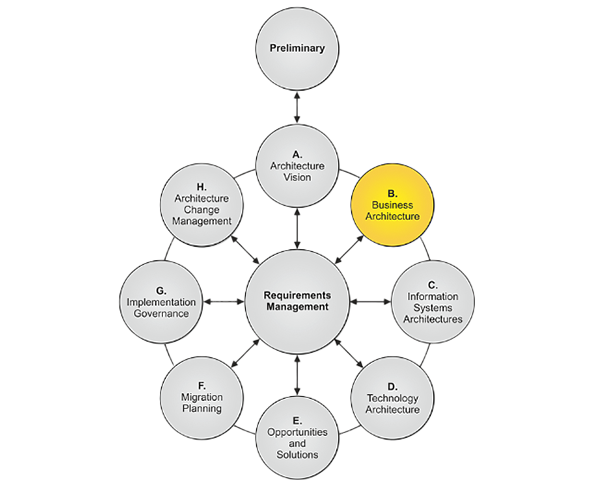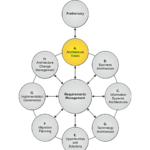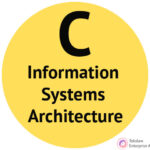in ADM Framework
In the world of enterprise architecture, few methodologies are as widely recognized and implemented as The Open Group Architecture Framework (TOGAF). Within this framework, one crucial component is the Architecture Development Method (ADM), which guides organizations through a structured approach to develop and manage their architecture. In this blog article, we will delve into the Business Architecture phase (Phase B) of the ADM, exploring its objectives, key activities, and outputs that are essential for organizational transformation.
What is Business Architecture?
At its core, business architecture defines the structure and strategy of an organization. It outlines how the business operates, including its processes, organizational structures, and ways in which it delivers value to its customers and stakeholders. The goal of Phase B is to establish a target business architecture, which represents the ideal state of the organization after it successfully implements its strategic transformation.
Baseline vs. Target Architecture
In the context of business architecture, we often discuss two key concepts: baseline architecture and target architecture.
Baseline Architecture: This term refers to the current state of the organization, encompassing existing structures, processes, and capabilities. It serves as the starting point for any transformation efforts.
Target Architecture: This represents the future state that the organization aspires to achieve, based on its vision and goals. The transition from baseline to target may not happen in a single leap; interim architectures may exist to facilitate the journey.
From Baseline to Target
One of the primary purposes of Phase B is to identify the architectural roadmap items required to move from the baseline to the target architecture. This involves conducting a gap analysis to determine the necessary changes and improvements across various business aspects. The gap analysis will reveal discrepancies between the current and desired states, allowing you to create a clear plan to address these gaps.
Identifying roadmap items includes not only recognizing what needs to change but also organizing these changes in a logical sequence. Some items may have dependencies (meaning certain tasks must be completed before others) while others may be more flexible in their timing.
Key Inputs for Phase B
The inputs for Phase B are crucial as they provide the foundation for structured analysis and planning. These include:
External Reference Materials: Research or documentation from other organizations that can inform your approach.
Request for Architecture Work: Documentation from Phase A that outlines the need for architectural changes.
Business Principles and Goals: Defined in the previous phase, these guide the direction of the architecture work.
Capability Assessment: Evaluates current capabilities and resources to determine strengths and weaknesses.
Additionally, the architecture repository and enterprise continuum help catalog existing architectural artifacts, ensuring all relevant information is available as you build your business architecture.
Performing the Gap Analysis
The gap analysis process is crucial in Phase B. It involves identifying the differences between the baseline and target architecture. For certain areas of the business where processes or structures need to change, detailed documentation will outline what modifications are needed and why.
If there are sections of the business that remain unchanged, it’s just as important to recognize these areas, as they validate what is already working well.
Identifying and Resolving Impacts
The phase also includes analyzing conflicts between different organizational goals. For instance, a common conflict might arise between the desire to enhance customer service while also cutting operational costs. Identifying these conflicts (or impacts) early on allows stakeholders to negotiate and reach agreeable solutions to align with overall strategic objectives.
Presenting to Stakeholders
After completing the gap analysis and identifying roadmap items, it’s time to present the findings to stakeholders. This formal review is essential for gathering feedback, addressing concerns, and refining the business architecture before moving on to the next phases of technology and application planning.
Outputs of Phase B
The outputs from Phase B form critical documentation that serves as a reference throughout the transformation journey. These include:
Finalized Business Architecture Definition: A thorough and formalized version of how the business will operate post-transformation.
Updated Gap Analysis: Identifying the key changes needed to reach the target architecture.
Roadmap of Architecture Items: Detailing the sequence and dependencies of tasks needed for implementation.
As a result, organizations create a variety of artifacts,such as models, diagrams, and catalogs,that clarify business interactions and processes without yet delving into technology specifics.
Conclusion
In summary, the Business Architecture phase of the ADM framework is a foundational step in transforming an organization to achieve its strategic vision. By defining both baseline and target architectures, conducting a thorough gap analysis, and developing a roadmap to bridge the two, organizations can ensure their journey is well-structured and aligned with their overarching goals. As you embark on this journey, remember that the insights gained in Phase B will significantly influence the success of your enterprise architecture efforts moving forward.
With a strategic approach to business architecture, your organization will be well on its way to becoming more efficient, customer-focused, and resilient in the face of change.



